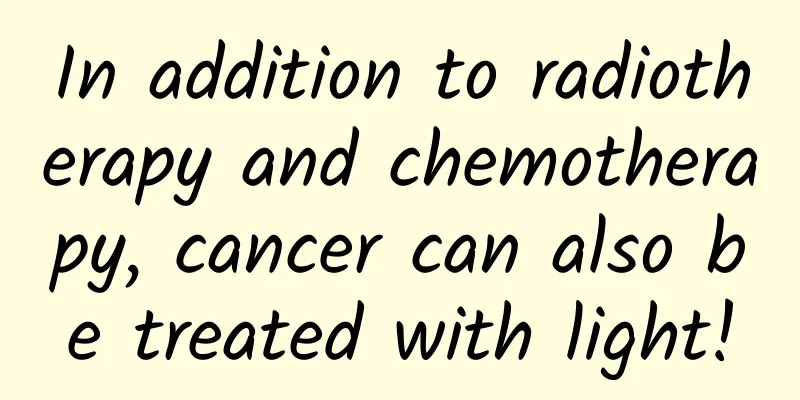In addition to radiotherapy and chemotherapy, cancer can also be treated with light!

|
Author: Zhao Guohui (Shanghai Institute of Optics and Precision Mechanics, Chinese Academy of Sciences) The article comes from the Science Academy official account (ID: kexuedayuan) To treat cancer, you probably think of surgery, radiotherapy, chemotherapy, and immunotherapy. But did you know that light can also fight cancer? Photodynamic therapy is a new selective treatment technology that was introduced in the late 1970s and has developed rapidly in recent years. This therapy has the advantages of less trauma, good selectivity, low toxicity and no drug resistance. Figure 1 Two-photon dynamics therapy (Source: Shanghai Dragon TV) Realizing optical imaging and diagnosis and treatment of deep tumors has always been the direction of efforts of researchers in interdisciplinary research fields such as biomedicine and optics. The Shanghai Institute of Optics and Fine Mechanics of the Chinese Academy of Sciences has cooperated with the Hong Kong University of Science and Technology. In the recent two-photon photodynamic therapy research, 800nm femtosecond laser was used to achieve deep tumor diagnosis and treatment in mice, providing a new diagnosis and treatment plan for deep tissue tumor treatment. The related paper "AlPcS-loaded gold nanobipyramids with high two-photon efficiency for photodynamic therapy in vivo" was published in the academic journal Nanoscale (please click "Read original text" to read the paper). Three steps to understand photodynamic therapy Photodynamic therapy is a new method of treating tumors using three elements: photosensitizer, laser and oxygen molecules. Seeing this, you may have a lot of questions in your mind: What is two-photon? What is a photosensitizer? How do they treat tumors? Two-photon: When a unit photosensitizer is excited by a laser, two photons are required to participate in the reaction simultaneously. Photosensitizer: A compound that can absorb photons and transfer energy to oxygen molecules during photodynamic therapy. It is equivalent to an intermediary for energy transfer. Two-photon dynamics therapy for tumor treatment is mainly divided into three steps (the animation is drawn by the author): The first step is to accurately identify tumor cells. This step is mainly completed by the photosensitizer and the photosensitizer delivery carrier. The photosensitizer delivery carrier is like a transport vehicle that matches the photosensitizer and transports the photosensitizer to the target location. At present, a relatively efficient and accurate method is to modify the targeting molecule on the carrier surface or the photosensitizer, which can bind to the receptors on the surface of tumor cells without binding to normal cells, and then enter the tumor cells through endocytosis. Drawn by the author The second step is to irradiate the marked area with laser. When there is no light irradiation, the photosensitizer has good dark stability and will stay "quietly" inside the tumor cells, with basically no toxic side effects. When the laser irradiates the tumor tissue, the delivery carrier loaded with the photosensitizer will be excited by two photons to reach the singlet state, and then reach the triplet state through intersystem crossing. Because the triplet state has a long lifetime, it can react with the surrounding oxygen, water, etc. to produce singlet oxygen, superoxide ions, free radicals and other active substances, which are highly oxidizing or reducing. Drawn by the author The third step is to eliminate tumor cells. There are three main ways for reactive oxygen species to eliminate cancer cells: one is to destroy the microvessels near the tumor tissue, causing insufficient blood supply to the lesion, indirectly leading to tumor cell death; another is to bind to intracellular proteins, DNA, lipids, etc. to inactivate cells and cause tumor cell apoptosis, necrosis or autophagy; another way is to locally induce nonspecific emergency inflammatory reactions and a series of immune responses in the later stage, which has a sustained systemic effect on inhibiting and destroying tumors. Drawn by the author How to solve the two major problems? At present, photosensitizers based on photodynamic therapy have been put into clinical use. For example, the photosensitizer benzoporphyrin derivative monoacid was approved by the US Food and Drug Administration (FDA) in 2000 for the clinical treatment of cancer and retinal macular degeneration; hematoporphyrin monomethyl ether developed by the Second Military Medical University of my country has also been marketed and approved for the clinical treatment of port-wine stains. However, the clinical application of photodynamic therapy is currently limited to skin diseases or superficial tumors. The main shortcomings of this therapy are: 1. The photosensitizer lacks sufficient targeting to tumor tissues and phototoxicity; the so-called phototoxicity means that after the photodynamic therapy is over, the photosensitizer cannot be immediately metabolized and excreted from the body. When the patient is exposed to sunlight, fluorescent light and other light, the photosensitizer retained in the normal tissue can still be used for photodynamic therapy, destroying normal cells and producing phototoxicity; 2. Since the photosensitizer needs to react with light, and the light has poor penetration ability in human tissues, it is difficult to perform deep treatment. This time, the Shanghai Institute of Optics and Fine Mechanics mainly solved the problem of poor light penetration in the research of photodynamic therapy. They designed and tested new gold nanobipyramids to load photosensitizers. Gold nanobipyramids are chemically inert and have low biological toxicity, stronger local electric field enhancement and extremely high two-photon cross-section. Their two-photon cross-section is several orders of magnitude higher than that of the photosensitizer itself, and they can more efficiently transfer energy to the attached photosensitizer, indirectly sensitizing oxygen molecules and producing more reactive oxygen. In order to enable light to reach deeper areas, they used 800nm femtosecond pulse laser in the bio-optical window (i.e. the wavelength range where the penetration depth of light in biological tissue reaches the maximum) to irradiate the marked area. At the same time, laser light of this wavelength also has less phototoxicity to normal tissues and cells. How effective is two-photon cancer treatment? Is this treatment effective for deep-seated cancer? Let's use experimental data to determine whether it works. The researchers established a mouse tumor model. After the tumor grew for 2 weeks and reached a volume of about 100-150 mm3, they randomly divided the tumor-bearing mice into four groups and set up four experiments: 1. Buffer solution (PBS) group; 2. Photosensitizer: aluminum phthalocyanine (AlPcS) group; 3. Photosensitizer delivery carrier: gold nanobipyramid (GBP); 4. Complex of photosensitizer and delivery vehicle (GBP-AlPcS). The first group of experiments served as the control group, and the other three groups served as experimental groups. Four groups of mice were injected with the corresponding drugs, and then irradiated with 800nm femtosecond laser at an intensity of 2.8W/cm2 for 30 minutes 2 hours after injection. The mice were injected with drugs and irradiated on the 1st and 9th days respectively. Body weight and tumor size were measured every two days after treatment, and finally tumor tissues of representative mice were removed 18 days after the start of treatment. The tumor treatment effect of the contrast therapy and its toxic side effects on the organism were compared. The experimental results are shown in the figure below: Figure 2 Changes in mouse body weight and tumor volume over time (Image source: paper) Figure 3 The status of tumors after the four groups of experiments (Image source: paper) The results showed that there was significant tumor growth inhibition in Group 4. Figure 2-A shows that all groups showed moderate weight growth and a survival rate of 100%, indicating that the selected therapeutic diagnostic agent had no significant acute toxicity. The trend in Figure 2-B shows that the inhibitory effect of GBP-AlPcS on tumor growth under 800nm fs irradiation was significant. Figure 3 observed obvious hemorrhagic lesions at the tumor site of Group 4 mice, indicating effective tumor inhibition. During the study period, tumors in Groups 1 and 2 grew significantly, indicating that neither light irradiation alone nor AlPcS injection alone could inhibit tumor growth. This experiment shows that the GBP-AlPcS therapeutic diagnostic agent has no obvious acute toxicity and can significantly inhibit the growth of deep tissue tumors in the body. In order to further understand the therapeutic effects of various methods, the tumor tissues, as well as the heart, liver, spleen, lung, and kidney organs of each group of treated mice were processed and observed. The experimental results are shown in Figures 4 and 5 respectively: Figure 4 Cell morphology (top) and cell apoptosis (bottom) of tumor sections in each experimental group (Image source: paper) Figure 5 Staining images of the main organs of experimental mice (Source: Paper) As shown in Figure 4, obviously extensive tumor necrosis was observed only in tumors with GBP-AlPcS treatment. In the GBP-treated group, scattered necrotic areas were surrounded by malignant cells and accompanied by nuclear atypia. This may be due to the photothermal effect of GBP under fs laser irradiation. In the PBS- and free AlPcS-treated groups, H&E and TUNEL-stained sections did not show any obvious tumor necrosis. The results indicate that GBP-AlPcS can be used as a highly efficient two-photon dynamic therapy agent. As shown in FIG5 , drugs including free AlPcS, GBP and GBP-AlPcS treatment had no significant damage to normal tissues including heart, liver, spleen, lung and kidney, indicating that this therapy had no observable side effects or toxicity to normal tissues. Future: Both penetration and high precision are needed! The composite GBP-AlPcS has great potential for clinical translation from proof-of-concept to real clinical practice, and experimental results show that the system has the potential to improve the therapeutic depth and precision of traditional photodynamic therapy. In the next research plan, the researchers will look for light sources with stronger penetration and suitable photosensitizers to match them, striving to achieve both penetration and high precision in tumor treatment. In the future, cancer may really be “eradicated”! |
<<: When “fever” meets “new coronavirus pneumonia”, how to choose antipyretic drugs?
>>: Which high blood pressure medicines should not be taken first?
Recommend
Can a wasp sting kill a person? What should people who are allergic to bee venom do if they are stung by a bee?
Wasps are also called yellow jackets. They are th...
Can carotid artery plaques really be reversed? To reverse plaques, certain conditions must be met
A friend asked Huazi that she had been taking sta...
What to do if you have stomach pain after abortion
With the continuous progress of society, more and...
B-ultrasound amniotic fluid index and measurement
Speaking of the medical term amniotic fluid, it i...
How long is normal for bleeding?
When a couple is not ready to welcome the birth o...
Why doesn't petunia grow tall? How to prune petunia?
Petunias and morning glories are biologically the...
How many days after menstruation does a woman ovulate?
Many people need to understand the ovulation peri...
Understand the "little temper" of the intestines - irritable bowel syndrome, and protect intestinal health
Author: Ren Qingling Unit: Shanxi Bethune Hospita...
What to do if anemia is severe during pregnancy
Anemia during pregnancy is a very common phenomen...
How to adjust female sexual indifference
Generally speaking, if a woman has a problem with...
Which gynecological anti-inflammatory drug is better?
Gynecological diseases often occur to women who d...
Common antipyretics for children, different usages should be remembered
Children are not smaller versions of adults. They...
How long after abortion can I eat spicy food
You should pay special attention to your diet aft...
When do girls usually have their periods?
Most women are still in a state of ignorance afte...
Why don't polar bears eat penguins? Are there penguins in the Arctic?
Penguins mainly live in the Antarctic region. The...









